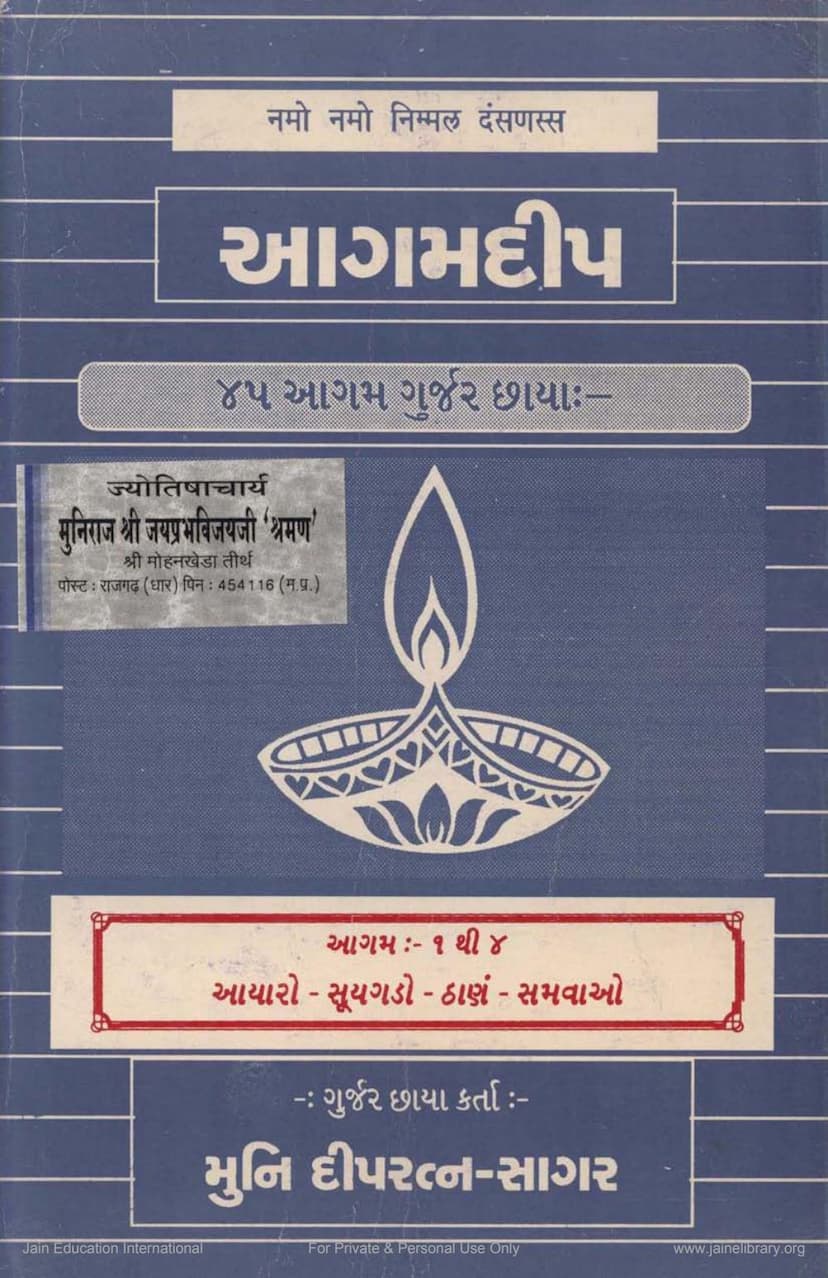Agam Deep 18 Jambudwippannatti Gujarati Anuvaad
Added to library: September 1, 2025

Summary
The provided text is a Gujarati translation and commentary ("Gurjar Chhaya") of the Jain Agam Sūtra called "Jambūdvīpaprapti," which is the 18th Upanga Sūtra. The commentary is by Muni Dipratnasagar and published by Agam Shrut Prakashan. The title "Agam Deep 18" suggests it's part of a larger series.
Here's a summary of the key information extracted from the text, focusing on its content and structure:
Book Details:
- Title: Agam Deep 18 Jambudwippannatti Gujarati Anuvaad
- Author: Dipratnasagar, Deepratnasagar
- Publisher: Agam Shrut Prakashan
- Nature: Gujarati translation and commentary (Gurjar Chhaya) of the Jain Agam Sūtra "Jambūdvīpaprapti" (18th Upanga Sūtra).
Content of the Commentary (Jambūdvīpaprapti Summary):
The text details the geography, cosmology, and history within Jainism, particularly concerning the Jambūdvīpa, the central continent of the Jain universe. The commentary, presented as a dialogue between Lord Mahavir's disciple Gautama and Mahavir himself, covers the following:
-
Cosmology and Geography:
- Jambūdvīpa: Described as the first of the continent and oceans, located in the center of the universe.
- Shape and Size: It's compared to a fried pancake or the moon in its fullness, with a circular shape. Its dimensions are given in Yojana (a unit of measurement). The circumference is calculated in detail.
- Vajra Jagati: The Jambūdvīpa is surrounded by a golden rampart called Vajra Jagati, described as being eight yojanas high, tapering from twelve yojanas wide at the base to four yojanas at the top, giving it a "cow's tail" shape. It's made of various gems and is lustrous, pure, and radiant.
- Padmavaravedika and Vanakhanda: Inside the Vajra Jagati, there's a beautiful lotus-like pedestal (Padmavaravedika) and a vast forest tract (Vanakhanda).
- Rivers and Mountains: Descriptions of major rivers like Ganga and Sindhu, and mountains like the Vaitaldhya mountain range are provided.
- Regions (Kshetras): The text elaborates on the different regions within Jambūdvīpa, primarily focusing on:
- Bharat Kshetra: Detailed descriptions of its characteristics, including its formation, terrain (thorny trees, pits, caves, rivers, lakes), inhabitants, and various adversities faced by its people (wild animals, thieves, drought, famine, heretics, etc.). The text also describes the characteristics of people in different eras within Bharat Kshetra, especially during the descending (avasarpini) and ascending (utsarpini) time cycles, detailing the decline in lifespan, physique, and moral conduct.
- Harivarsha and Ramyakavarsha: Mentioned as areas with beautiful landscapes and specific human characteristics and lifespans.
- Haimavata and Hairanyavata: Described as regions with beautiful land, inhabited by humans with specific lifespans and characteristics.
- Mahavideha: This is a special region described as a "karma-bhūmi" where Tirthankaras are born. It's characterized by constant happiness, beautiful landscapes, and inhabitants with specific lifespans and characteristics. The text describes the cyclical nature of time periods (āras) within Mahavideha and the characteristics of its inhabitants. It highlights the birth of Tirthankaras, their lives, renunciations, and attainment of Kevala Jnana (omniscience).
- Devakuru and Uttaraguru: These are described as regions where people live blissfully, with specific divine characteristics.
-
Cosmic Calculations:
- Time Measurement: The text delves into Jain cosmology's detailed time calculations, defining units like āvalikā, kṣullaka bhava, uśvāsa-niśvāsa (prāṇa), stoka, lava, muhūrta, aharātra (day-night), paksha (fortnight), māsa (month), ṛtu (season), ayana (six-month period), samvatsara (year), yuga, shata varsha (hundred years), sahasra varsha (thousand years), lakṣha varsha (lakh years), purvāṅga, pūrva, etc. These calculations are vast and intricate.
- Planetary and Stellar Bodies: Discussions about the number of suns, moons, planetary systems (grahas), constellations (nakṣhatras), and their movements are present. Their distances from Mount Meru and their measurements are described.
-
Key Figures and Concepts:
- Tirthankaras: The text discusses the lives of Tirthankaras, particularly the first Tirthankara, Lord Rishabhadeva (Adinath), his birth, his teaching of arts and sciences, his renunciation, his ascetic practices, and his attainment of Kevala Jnana. The concept of Kulakaras (progenitors) is also mentioned.
- Chakravartis: The reign and conquests of the Chakravarti king Bharata are extensively narrated, detailing his military campaigns, his divine attributes, the possession of the Sudarshana Chakra (the divine discus), his administration, and his eventual renunciation.
- Deities: Various classes of deities (Vānavyañtara, Jyotiṣka, Vaimānika) and their roles, mansions (vimānas), and rituals are described. The interaction of these deities with Tirthankaras and Chakravartis is also mentioned.
-
Structure and Commentary Style:
- The commentary ("Gurjar Chhaya") aims to explain the complex Jain Sūtras in simple Gujarati.
- It often follows a question-and-answer format between Mahavir and Gautama.
- The text includes extensive descriptions of geographical features, astronomical bodies, calculations of time and space, and historical accounts of figures within Jainism.
- The publisher has listed various other publications, suggesting a dedicated effort to spread Jain knowledge.
- The emphasis on monetary contributions for the publication highlights its support structure.
Overall Purpose: The "Agam Deep" series, and specifically this volume on Jambūdvīpaprapti, serves to make the profound teachings of Jain Agamas accessible in Gujarati, facilitating Jain education and spiritual understanding. The detailed descriptions of Jambūdvīpa, its regions, time cycles, and the lives of exemplary beings like Tirthankaras and Chakravartis are central to this purpose.